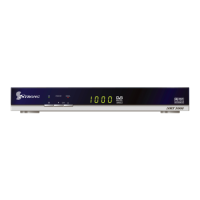Why doesn't my Strong Receiver show the channel number or time on the front panel?
- TTheodore TurnerSep 10, 2025
This Strong Receiver model does not have a display for showing the channel number or time.

Why doesn't my Strong Receiver show the channel number or time on the front panel?
This Strong Receiver model does not have a display for showing the channel number or time.
What to do if my Strong TV Receiver has no picture and sound?
If your Strong TV Receiver shows no picture and sound, first verify that your TV is set to the correct AV mode. Then, check that the cables connecting the TV and the receiver are properly connected, paying attention to the selected connection type: Component, S-Video, Composite, Audio, or Antenna.
Why is there no sound on my Strong SRT 5006 TV Receiver?
If you're experiencing no sound with your Strong TV Receiver, first check if the receiver or the TV is in Mute mode and, if so, press the MUTE button on the remote control of your receiver and TV. Also, ensure that the initial volume level has been set on your TV using your TV remote control.
| Type | Digital Satellite Receiver |
|---|---|
| Resolution | 1080p |
| Tuner | DVB-S2 |
| Input Frequency Range | 950-2150 MHz |
| Weight | 0.8 kg |
| Output | HDMI, RCA |
| Features | EPG |
| Symbol Rate | 1-45 Msps |
| DiSEqC | 1.0, 1.2 |
| Video Decoding | MPEG-2, MPEG-4 |
| Audio Decoding | MPEG-1 Layer 1, 2 |
| Video Output | PAL, NTSC |
| Power Supply | AC 220V |
Critical warnings regarding electric shock and general safe operation of the device.
General information about the Strong Digital Terrestrial Television Receiver and its compliance.
A list of the main features and functionalities offered by the receiver.
Description of the status indicators and channel selection buttons located on the front panel.
Detailed explanation of each connector on the back panel and its respective function.
Identifies and explains key remote control buttons used for navigating menus.
A comprehensive guide detailing the function of each button on the remote control.
Instructions for battery replacement and information on the remote control's operating range and conditions.
Illustrates how to connect the receiver using component video cables for enhanced picture quality.
Demonstrates the connection process using an S-Video cable for video output.
Explains the setup for composite video and stereo audio using RCA leads.
Detailed steps for connecting the receiver's component video and RCA audio outputs.
Guide for connecting the receiver using S-Video and associated audio connections.
Instructions for connecting composite video and audio via RCA cables.
Steps for connecting the TV antenna to the receiver's aerial input port.
Guide on powering on the receiver for the first time and performing an automatic channel scan.
Instructions on selecting the optimal A/V mode in the menu for video output.
Steps to configure and enable Dolby Digital audio output via a coaxial connection.
Setting the receiver's time and date, either automatically or manually.
Procedures to verify the signal strength and quality for optimal digital reception.
Guidance on repositioning the antenna to enhance signal reception.
How to use the TV Loop Out connector for passing aerial signals to other devices.
Various ways to select and change channels, including numeric entry and navigation.
How to adjust audio volume and use the mute feature.
Functions for pausing video playback and switching between TV and radio modes.
Using the EPG to view current and upcoming program information.
Adjusting the screen aspect ratio for optimal viewing of different content formats.
How to enable or disable closed captioning for accessibility.
Guide to using the Teletext service for text-based data.
Steps for creating, grouping, and managing favorite channels with custom headings.
Removing specific channels from user-created favorite lists.
Modifying the default names of favorite channel groups for better organization.
How to reorder channels and remove unwanted ones from the list.
Setting up channel locks with a password and renaming channels.
Browsing the channel list, including sorting and viewing broadcast previews.
Changing the language used for menu descriptions and on-screen interface elements.
Setting up timers for VCR/DVD recording based on broadcast events.
Configuring the receiver to automatically turn off after a specified time period.
Procedures for changing the receiver's default password for security purposes.
Implementing parental controls to restrict access to content based on ratings.
Adjusting the colour settings for various elements of the on-screen display menu.
Performing a manual scan to locate and tune into specific broadcast frequencies.
Steps to reset the receiver to its original factory default configuration.
Accessing information on the receiver's software version and hardware specifications.
A comprehensive guide for identifying and fixing common operational problems.
Comprehensive technical data covering demodulator, CPU, video/audio, dimensions, and power.